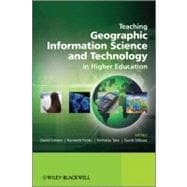
What is included with this book?
David Unwin and Nicholas Tate are the authors of Teaching Geographic Information Science and Technology in Higher Education, published by Wiley.
| About the editors | p. ix |
| List of contributors | p. xi |
| Foreword | p. xv |
| Editors' preface | p. xvii |
| Gis&t in the Academic Curriculum - Introduction | p. 1 |
| GIS&T in higher education: challenges for educators, opportunities for education | p. 3 |
| Making the case for GIS&T in higher education | p. 17 |
| The internationalization of Esri higher education support, 1992-2009 | p. 37 |
| Reflections on curriculum development in the US and abroad: from core curriculum to body of knowledge | p. 47 |
| Issues in Curriculum and Course Design | p. 61 |
| Using the GIS&T Body of Knowledge for curriculum design: different design for different contexts | p. 63 |
| Scope and sequence in GIS&T education: learning theory, learning cycles and spiral curricula | p. 81 |
| Building dynamic, ontology-based alternative paths for GIS&T curricula | p. 97 |
| Addressing misconceptions, threshold concepts, and troublesome knowledge in GIScience education | p. 117 |
| Active pedagogy leading to deeper learning: fostering metacognition and infusing active learning into the GIS&T classroom | p. 133 |
| Where to begin? Getting started teaching GIS&T | p. 145 |
| Issues in curriculum and course design: discussion and prospect | p. 159 |
| Perspectives on Teaching Gis&t | p. 165 |
| The University of Minnesota master of geographic information science (MGIS) program: a decade of experience in professional education | p. 167 |
| Geospatial education at US community colleges | p. 185 |
| The GIS Professional Ethics project: practical ethics for GIS professionals | p. 199 |
| An exploration of spatial thinking in introductory GIS courses | p. 211 |
| Teaching spatial literacy and spatial technologies in the digital humanities | p. 231 |
| Discussion and prospect | p. 247 |
| Digital Worlds and Teaching Gis&T | p. 255 |
| Virtual geographic environments | p. 257 |
| Using web-based GIS and virtual globes in undergraduate education | p. 289 |
| Trying to build a wind farm in a national park: experiences of a geocollaboration experiment in Second Life | p. 301 |
| From location-based services to location-based learning: challenges and opportunities for higher education | p. 327 |
| GIS is dead, long live GIS&T: an educational commentary on the opening of Pandora's Box | p. 345 |
| Distance and E-Learning | p. 359 |
| Media and communications systems in cartographic education | p. 361 |
| UNIGIS - networked learning over a distance | p. 383 |
| The Esri Virtual Campus | p. 395 |
| Delivering GIScience education via blended learning: the GITTA experience | p. 405 |
| GIS&T in the open educational resources movement | p. 421 |
| Experiences in 'e' and 'distance-' learning: a personal account | p. 439 |
| Conclusion | p. 451 |
| Ways forward for GIS&T education | p. 453 |
| Index | p. 469 |
| Table of Contents provided by Ingram. All Rights Reserved. |
The New copy of this book will include any supplemental materials advertised. Please check the title of the book to determine if it should include any access cards, study guides, lab manuals, CDs, etc.
The Used, Rental and eBook copies of this book are not guaranteed to include any supplemental materials. Typically, only the book itself is included. This is true even if the title states it includes any access cards, study guides, lab manuals, CDs, etc.